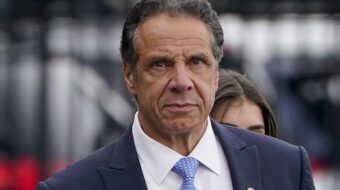Making the ‘dream’ a reality
MEMPHIS, Tenn. — Union members from across the U.S. are gathering here Jan. 17-21 for labor’s annual celebration of Dr. Martin Luther King Jr.’s birthday, and to commemorate the 40th anniversary of the history-making Memphis sanitation workers’ strike. King was assassinated here in 1968 while supporting the striking workers’ stand for dignity and union rights.
The gathering is far more than a commemoration, however. Trade unionists are holding intensive training sessions during the weekend, to prepare for unprecedented involvement in the 2008 elections. The AFL-CIO, which sponsored the event, is planning the most massive entrance into election campaigns ever by the nation’s unions.
Elections and the ‘dream’
“The courageous strike by the Memphis sanitation workers and the assassination of Dr. King when he came here to support them give us much to commemorate and reflect upon,” said Clayola Brown vice president of Unite Here and president of the Coalition of Black Trade Unionists. Brown chairs the Martin Luther King Labor Committee, which organized the gathering.
“This will be our point of departure into the election battles,” Brown said, “because full realization of Dr. King’s dream is not possible without big changes in our government. Only then will we be able to fight not just for civil rights but to protect jobs, to win the ability to form unions, to win peace and justice and to save the environment.”
The activities culminate Jan. 21 in a march through the streets of Memphis. Tens of thousand of unionists are expected to be joined by allies in the civil rights, social justice and peace movements.
Brown said the 1968 sanitation workers’ strike was “a valiant strike of men who dared to take a stand for dignity and respect on the job.” It was also Dr. King’s final campaign, she noted. This year in Memphis, she said, the labor movement would “join with our allies at the observance to advance the agenda for civil and workers’ rights and to carry on Dr. King’s legacy.”
Building union leadership diversity
The 40th anniversary commemoration comes as the union movement, particularly the AFL-CIO, continues to wrestle with how to implement the diversity agenda its convention approved in 2005. The agenda, known as Resolution #2, set a goal of having union leadership reflect the composition of the membership in representation of women, people of color and diversity of sexual orientation.
The AFL-CIO’s executive council has taken steps in this regard. Arlene Holt Baker, an African American woman, is now executive vice president. She replaces Linda Chavez Thompson, the first Latina to hold that position.
Four diversity summits last year drew 700 unionists from 33 unions, 20 state labor federations and 26 central labor councils. The summits showed the labor movement is still far from that goal, says a recent report by the federation’s Civil and Human Rights Department.
The report said there was general agreement among summit attendees that diversity was not only the right thing to do but also necessary if labor wants to make sure the union movement is strong. But the majority said they had not heard about Resolution #2 or the mandates the resolution imposed on their national unions or state and local labor bodies, the report added.
Participants said that getting information to members at local and regional levels was the only way to ensure implementation. They urged all national unions to get copies of Resolution #2 to their locals and regional bodies, and put them on web sites and in publications.
Recruitment and training
Summit participants said the union movement faces two problems: recruiting and training more women and minorities for leadership posts, and recruiting and training more young people. They advocated creating mentors, and appointing as well as electing women, minorities and younger unionists to leadership posts to give them experience and training.
Some unions have started to implement those ideas, the report said. In one case, an African American woman trade unionist, Charlotte Flowers, formed a slate at her American Federation of Government Employees local in Alabama, with an African American man as her running mate, to combat closed attitudes of the all-male leadership against women and minorities. They ran for office, and won.
The Chicago Federation of Labor realized that recruiting women and minorities for union leadership roles has to start even before they join the union — in this case by working to ensure women and minorities get the technical training needed for today’s modernized (and unionized) factories.
Unions reach out to youth of color
CFL Secretary-Treasurer Jorge Ramirez told summit participants that in coming years 70 percent of factory workers would retire, giving minorities an opportunity to enter manufacturing. So the CFL formed a partnership with business and the city to create a new technical factory-skills-oriented high school and to establish union-run pre-apprenticeship programs, he added. Austin Poly Tech was intentionally built in an African American neighborhood to help students of color get ready for these highly skilled jobs in the manufacturing sector, Ramirez added.
Despite these and other diversity efforts, the union movement still puts up “challenges and barriers to inclusion,” the AFL-CIO report said.
Diversity summit participants “acknowledged problems continue and that all union members are not included fully in the leadership and life of our unions and union structures,” the report concluded.
Mark Gruenberg from PAI news service contributed to this article.









